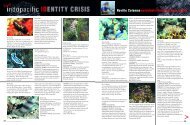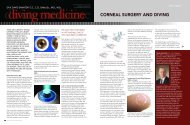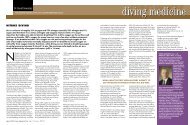BUNKERING DOWN ON A BIG CAT - Dive The Blue . net
BUNKERING DOWN ON A BIG CAT - Dive The Blue . net
BUNKERING DOWN ON A BIG CAT - Dive The Blue . net
Create successful ePaper yourself
Turn your PDF publications into a flip-book with our unique Google optimized e-Paper software.
76<br />
S P O R T D I V I N G M A G A Z I N E<br />
: NIGEL MARSH © 2008<br />
EIGHT reefs and coral cays at the<br />
southernmost end of the Great<br />
Barrier Reef make up the Bunker<br />
Group. This reef complex offers<br />
fantastic diving on colourful reef walls,<br />
rich coral gardens and magnificent<br />
bommies. <strong>The</strong> most famous island here<br />
is Lady Elliot, which has its own resort<br />
and dive operation, but the other reefs<br />
of the group are best dived from a<br />
liveaboard.<br />
For these Bunker trips Big Cat Reality<br />
departs from the port of Bundaberg,<br />
about four hours drive north of<br />
Brisbane. After boarding late in the<br />
afternoon, and receiving a safety<br />
briefing on the vessel and the diving,<br />
Big Cat Reality headed out on the<br />
overnight crossing. <strong>The</strong> following<br />
morning found us anchored at Lady<br />
Musgrave Island.<br />
<strong>The</strong> first dive on both trips was at<br />
Manta Ray Bommie at Lady Musgrave<br />
Island. This dive site hadn’t changed at<br />
all – healthy coral gardens and a<br />
scattering of bommies in 12 to 24 metres.<br />
<strong>The</strong>re were always masses of reef fish and<br />
quite a few pelagics cruising in mid water.<br />
<strong>The</strong> mantas were missing this trip, but<br />
we did see heaps of turtles. Around a<br />
dozen green turtles were sighted during<br />
the dive, probably because the trip<br />
coincided with the turtle breeding and<br />
egg laying season. One thing I did notice,<br />
that became more evident with every<br />
dive, was the large number of coral trout.<br />
This popular ‘table fish’ was only<br />
occasionally seen on Great Barrier Reef<br />
on trips I did during the 1980s. I can<br />
only assume greater protection from<br />
fishing pressures has contributed to coral<br />
trout numbers increasing.<br />
In 1989 we spent two days around Lady<br />
Musgrave exploring the wonderful<br />
dropoff on the southern side, drift diving<br />
into the large lagoon, plus two night<br />
dives in the lagoon. But strong southerly<br />
winds stopped us diving the dropoff, but<br />
in a day and a half we explored many<br />
sites on the calm northern side including<br />
Radar Fix, <strong>The</strong> Canyons, Entrance Wall,<br />
destination reportº<br />
+ <strong>ON</strong>E OF THE FIRST ARTICLES I WROTE FOR SPORTDIVING IN 1989 WAS CALLED ‘CRUISING THE<br />
BUNKERS’ ABOUT A FABULOUS LIVEABOARD TRIP TO THE BUNKER GROUP OF ISLANDS. RECENTLY<br />
I WENT BACK ALMOST 20 YEARS AFTER THAT FIRST TRIP. IT WAS A GREAT CHANCE TO COMPARE<br />
THE DIVING, MARINE LIFE AND HEALTH OF THE REEFS.<br />
<strong>BUNKERING</strong> <strong>DOWN</strong> <strong>ON</strong> A <strong>BIG</strong> <strong>CAT</strong><br />
<strong>BUNKERING</strong> <strong>DOWN</strong> <strong>ON</strong> A <strong>BIG</strong> <strong>CAT</strong><br />
Main image - A graceful manta ray glides<br />
over a bommie at Fairfax Islands.<br />
Inset top left -Helen Rose with a gorgonian<br />
fan surrounded by baitfish.<br />
Above - A large tawny nurse shark rests next<br />
to a bommie at Lady Musgrave Island.<br />
Below left to right - A coral trout relaxes on<br />
the bottom while getting cleaned by cleaner<br />
wrasse; A giant moray eel draped in the<br />
staghorn coral at Hoskyn Islands.
78<br />
DIVING THE BUNKERS<br />
For more info on the Great Barrier<br />
Reef visit www.gbrmpa.gov.au<br />
S P O R T D I V I N G M A G A Z I N E<br />
Entrance Bommie and had a night dive<br />
in the lagoon.<br />
<strong>The</strong> abundant reef fish included wrasse,<br />
angelfish, butterflyfish, parrotfish,<br />
lizardfish, anemonefish, surgeonfish,<br />
damsels, fairy basslets and rock cods to<br />
name a few. We also found shrimps,<br />
crabs, crayfish, nudibranchs, clams,<br />
seastars, featherstars, octopus, turtles,<br />
stingrays, moray eels, pelagics plus a very<br />
large Maori wrasse. <strong>The</strong> best dive was on<br />
the Entrance Bommie, a large formation<br />
in 23 metres riddled with ledges and<br />
small caves and populated with millions<br />
of baitfish. Swarming trevally feeding on<br />
the baitfish constantly zoomed around<br />
us. I also found a 2.5m long tawny nurse<br />
shark under a ledge and managed a few<br />
shots before this shy shark swam off.<br />
Back in 1989 night dives in Lady<br />
Musgrave Lagoon were great. Only eight<br />
metres deep, the lagoon is dotted with<br />
small coral heads and we saw lionfish<br />
hunting, a variety of crustaceans and<br />
molluscs, plus many sleeping reef fish.<br />
This time I was too tired (must be<br />
Juvenile tall-fin batfish at Manta Ray<br />
Bommie, Lady Musgrave Island.<br />
Adding a splash of colour to any dive are<br />
Rainford’s butterflyfish.<br />
Red emperors, once fished out from many<br />
sites, are making a comeback in the Bunker<br />
Group.<br />
A speckled grubfish awaits prey, sitting on<br />
the sand at Hoskyn Islands.<br />
Big Cat Reality anchoring at Hoskyn Islands.<br />
Green turtles nest on the coral cays of the<br />
Bunker Group and are regularly encountered<br />
by divers.<br />
A dive brief underway on Big Cat Reality’s<br />
large dive deck.<br />
GLADST<strong>ON</strong>E<br />
QUEENSLAND<br />
Llewellyn Reef<br />
Hoskyn<br />
Islands<br />
Bundaberg<br />
Fitzroy Reef<br />
Boult Reef<br />
Fairfax Islands<br />
Lady<br />
Musgrave<br />
Island<br />
B U N K E R<br />
G R O U P<br />
H E R V E Y<br />
B AY<br />
Fraser<br />
Island<br />
getting old!) for the lagoon night dive so<br />
I missed the manta ray that cruised<br />
around our divers!<br />
FAIRFAX ISLANDS<br />
Next stop on both trips was the twin<br />
coral cays of Fairfax Islands. On the<br />
north side of Fairfax Islands are countless<br />
coral bommies in depths from 12 to 24<br />
metres. In 89 we found a huge bommie,<br />
we named Swim Thru Bommie; it was<br />
the size of a two-storey house and cut<br />
with ledges, caves and several<br />
swimthroughs. It was sheltering<br />
thousands of cardinalfish, tasselled<br />
wobbegongs, a huge moray eel, lionfish,<br />
sweetlips, gropers and reef fish. We also<br />
found turtles, stingrays, Maori wrasse<br />
and a leopard shark. It was so good we<br />
stayed for three dives!<br />
I thought nothing would top that<br />
bommie at Fairfax Islands, but on our<br />
first dive here this trip we explored<br />
another fabulous group of bommies. First<br />
a large Maori wrasse and then found a<br />
tawny nurse shark in a cave. Moving<br />
slowly from bommie to bommie we<br />
found a massive black blotched stingray,<br />
two tasselled wobbegongs in cave full of<br />
cardinalfish, trevally, an estuary groper<br />
and numerous reef fish. At the end of<br />
the dive a three-metre-wide manta ray<br />
cruised in and then hung under the boat<br />
feeding and being cleaned by the cleaner<br />
wrasse crew. It was only low air forced<br />
me out of the water.<br />
We dived a variety of bommies at Fairfax<br />
Island, the crew would find another<br />
interesting lump on the depth sounder<br />
and we’d jump in and explore. Each<br />
bommie delivered something new and<br />
exciting. We saw lots of turtles, moray<br />
eels, tasselled wobbegongs and also a<br />
huge black manta ray. <strong>The</strong>re were also a<br />
couple of nice wall dives at a site called<br />
Tag Wall. As we drifted past it there were<br />
lots of ledges to investigate. We found<br />
barramundi cod, nudibranchs, octopus,<br />
moray eels, crayfish, lionfish, pipefish,<br />
ornate wobbegongs and even a leaf<br />
scorpionfish. <strong>The</strong> finale was four smoothtail<br />
mobula rays (a dwarf manta ray<br />
species) performing an underwater ballet<br />
while we hung on the safety stop.<br />
HOSKYN ISLANDS<br />
<strong>The</strong> bommies on the northern side of<br />
Hoskyn Islands are also spectacular. This<br />
was a 1989 highlight – we saw several<br />
manta rays and also encountered<br />
whitetip reef sharks, turtles and several<br />
destination reportº<br />
very big stingrays. This trip I was<br />
impressed by four red emperors (another<br />
rarely-seen ‘table fish’) on our first dive.<br />
<strong>The</strong>se striking creatures, with their<br />
prominent red bands, were gathered<br />
under a wide ledge. Red emperors were<br />
seen on almost every dive at Hoskyn<br />
Islands.<br />
<strong>The</strong> bommies here were magic. Several<br />
were decorated with spiky soft coral and<br />
gorgonians, and all were massed with<br />
coral trout and reef fish. Stingrays,<br />
trevally, barracuda, mackerel, sweetlip<br />
and barramundi cod were just some<br />
species we encountered. Massive moray<br />
><br />
S P O R T D I V I N G M A G A Z I N E 79
80<br />
Tasselled wobbegong surrounded by a halo<br />
of baitfish;<br />
eels were also a feature at Hoskyn<br />
Islands. On almost every dive we<br />
encountered at least one of these two<br />
metre long eels hanging out of a hole in<br />
a bommie, one was even draped through<br />
the staghorn coral – a perfect model!<br />
FITZROY REEF<br />
We skipped Fitzroy Reef in 1989 for<br />
several nice dives on the Boult Reef coral<br />
gardens. <strong>The</strong> Big Cat Reality trip gave us<br />
three lovely dives at Fitzroy Reef on the<br />
wall, bommies and coral gardens on the<br />
north side of the reef. This reef had the<br />
S P O R T D I V I N G M A G A Z I N E<br />
most degraded hard corals, many algae<br />
covered, that I saw this trip. Prior to this<br />
the corals appeared to be very healthy,<br />
with no apparent bleaching and only a<br />
few crown of thorns starfish. Even<br />
though the corals looked at little sad<br />
here, fish populations were good.<br />
At Uncle Pete’s Bommie we saw the first<br />
whitetip reef shark of the trip. Drifting<br />
slowly along the reef we also found<br />
several anemones full of pink<br />
anemonefish plus some very big red<br />
coloured pineapple sea cucumbers<br />
looking like an alien being. But the<br />
highlight of this dive was finding a baby<br />
barramundi cod only a mere four<br />
centimetres long that was slowly moving<br />
through the coral like a flatworm. At<br />
other sites here we encountered tasselled<br />
wobbegongs, morays, stingrays,<br />
nudibranchs, crayfish, trevally, parrotfish,<br />
octopus and a tiny spotted eagle ray.<br />
After almost 20 years the Bunker Group<br />
is still an impressive dive destination. I<br />
enjoyed every dive and was delighted to<br />
see the coral and marine life was as good<br />
as it was on my first trip. Twenty years<br />
on, cruising the Bunker Group is still one<br />
of the best Great Barrier Reef experience.<br />
<strong>BIG</strong> <strong>CAT</strong> REALITY FACILITIES<br />
This 25m long, 10m wide catamaran<br />
caters for 24 divers and eight crew. Fully<br />
airconditioned; lounge area; 2 x dining<br />
areas; Fully licensed bar with ice maker<br />
and large walk-in cold room; PS system,<br />
CD Player AM/FM stereo to all decks; TV<br />
& video; large barbecue; freezer capacity;<br />
4 good toilets; 5 showers; 28<br />
airconditioned berths; huge covered top<br />
deck, (the party deck)<br />
DIVE EQUIPMENT<br />
K180 Bauer Compressor - (KAP180-20E) 3<br />
phase Electric: 660 l/min - 21 cfm, approx.<br />
4.5 mins to fill scuba tank; large tank rack<br />
with seat for 24 divers comfortably and 4<br />
filling whips for easy refilling; 4 entry<br />
points and a submersible duckboard with<br />
full handrails for easy recovery; 4.2 metre<br />
rigid inflatable rescue vessel with centre<br />
console, depth sounder and GPS; large<br />
diving lights for night dives; medical<br />
oxygen equipment with 1 large G, 1 D<br />
size medical O2 first aid equipment; 2<br />
shot lines, 30m J line and float line to<br />
anchor chain; 2 areas with large<br />
whiteboards for onboard training between<br />
dives; fin bin; safety bar at 5 metres;<br />
wetsuit rack with fixed hangers<br />
Info and bookings -<br />
www.bigcatreality.com








